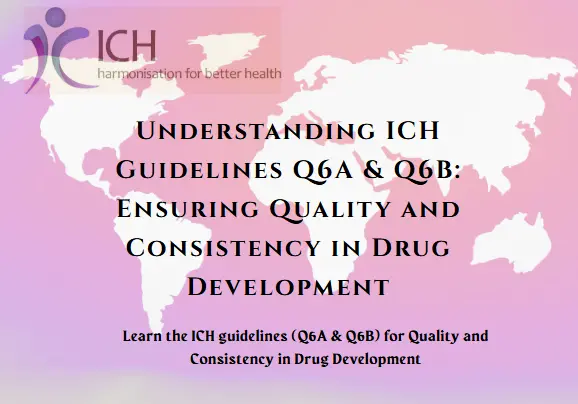Learn the ICH guidelines (Q6A & Q6B) for Quality and Consistency in Drug Development
Understanding ICH Guidelines Q6A & Q6B: Ensuring Quality and Consistency in Drug Development
The International Council for Harmonisation of Technical Requirements for Pharmaceuticals for Human Use (ICH) plays a pivotal role in aligning global pharmaceutical standards. By bringing together regulatory authorities and industry experts, ICH fosters scientific discussions that lead to the harmonization of drug registration processes worldwide.
ICH- international council for harmonization of technical requirements for pharmaceuticals for human use (ICH) is unique in bringing together the regulatory authorities and pharmaceutical industry to discuss scientific and technical aspects of drug registration. ICH mission is to achieve greater harmonization worldwide to ensure that safe, effective and high quality medicines are developed and registered in the most resource –efficient manner. Harmonization achievements in quality area include pivotal milestone such as the conduct of stability studies, defining relevant thresholds for impurities testing and a more manufacturing practice (GMP) risk management.
The Mission of ICH
The ICH’s mission is clear: to promote global harmonization that ensures safe, effective, and high-quality medicines are developed and registered efficiently, saving time and resources. Its harmonization efforts in the quality domain have led to major advancements, including:
- Standardized stability studies
- Defined thresholds for impurity testing
- Enhanced GMP-based risk management strategies
Among the key quality guidelines are ICH Q6A and ICH Q6B, which define the specifications and acceptance criteria for new chemical and biological drug products.
ICH Q6A: Specifications for New Chemical Drug Substances and Products
This guideline is intended to assist to the extent possible, in the establishment of a single set of global specifications for
new drug substances and new drug products. It provides guidance on the setting and justification of acceptance criteria
and the selection of test procedures for new drug substances of synthetic chemical origin, and new drug products
produced from them, which have not been registered previously in the United States, the European Union, or Japan.
The ICH Q6A guideline is designed to help establish global specifications for new drug substances and new drug products of synthetic chemical origin. It provides detailed direction on setting test procedures and acceptance criteria that ensure product safety and consistency.
Key Highlights:
- Applies to new drug substances and products not yet registered in the U.S., EU, or Japan.
- Focuses on quality assurance, including:
- Product design and development
- In-process and GMP controls
- Process validation
- Release and shelf-life specifications
Dosage Forms Covered:
- Solid and liquid oral dosage forms
- Small and large volume parenterals
While the guideline doesn’t directly cover biotechnological products or large peptides, it may apply to synthetic/semi-synthetic antibiotics and low-molecular-weight peptides. It excludes radiopharmaceuticals, fermentation products, herbal medicines, and animal/plant crude products.
Flexible & Forward-Looking:
The Q6A guideline encourages the use of new and emerging analytical technologies, as long as their use is scientifically justified, allowing for innovation without compromising product quality.
ICH Q6B: Specifications for Biotechnological/Biological Products
ICH Q6B offers guidance for setting test procedures and acceptance criteria for a wide range of biotechnological and biological products, such as:
- Recombinant proteins
- Polypeptides and derivatives
- Conjugated protein products
These substances are typically produced using cell culture systems (recombinant or non-recombinant) and must be highly purified and thoroughly characterized using sophisticated analytical methods.
Products Covered:
- Therapeutic proteins from cell cultures
- Some proteins isolated from tissues or body fluids (applicability to be confirmed with regulators)
Products Not Covered:
- Antibiotics
- Synthetic peptides and polypeptides
- Vitamins and cell metabolites
- DNA-based products
- Whole blood and blood components
- Vaccines and allergenic extracts
Importantly, Q6B does not specify exact test methods or criteria, allowing flexibility. It also does not apply to preclinical or clinical research materials.
Conclusion: The Role of Harmonization in Global Drug Quality (Q6A & Q6B)
The ICH guidelines, particularly Q6A and Q6B, have significantly advanced pharmaceutical quality standards. Key harmonization achievements include:
- Conducting standardized stability testing
- Setting impurity thresholds
- Implementing GMP-based risk management
By promoting consistency across regulatory regions, these guidelines ensure that both chemically synthesized and biologically derived drug products meet stringent quality and safety standards—ultimately benefiting public health and supporting global pharmaceutical innovation.
Harmonization achievements in the quality area include pivotal milestones such as the conduct of stability studies, defining relevant thresholds for impurities testing and a more flexible approach to pharmaceutical quality based on Good Manufacturing Practice (GMP) risk management

